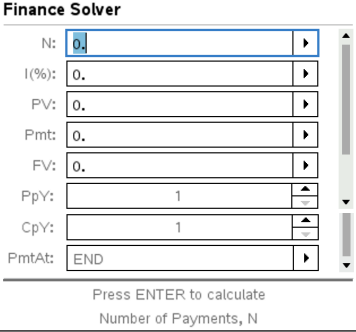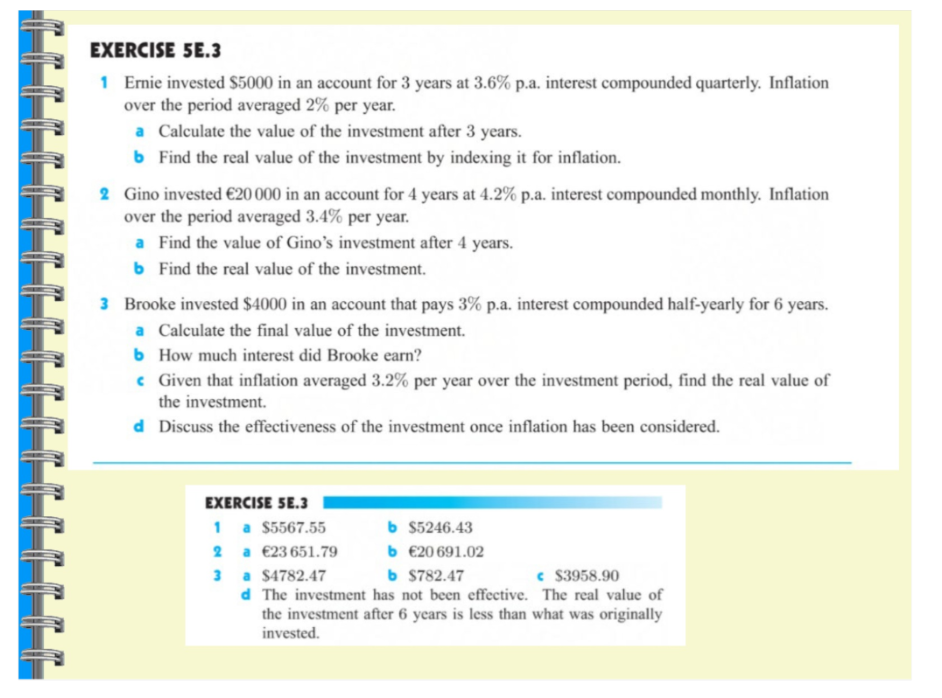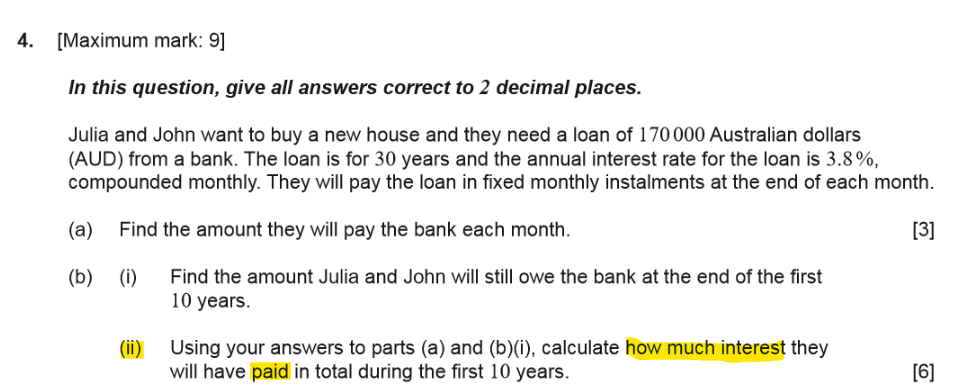FINANCIAL MATHS
COMPOUND INTEREST
compound interest (def). interest where the money earnt in deposited at a certain frequency and is used to calculate the next interest payment - e.g. superannuation or investments
FV = PV x (1 + r/100k)^kn
FV = Future Value - how much money in total after the investment period has ended
PV = Present Value - how much money has been invested to begin with
k = how many times a year the interest is paid
e.g. yearly, k = 1
monthly, k = 12
weekly, k = 52
quarterly, k = 4
half yearly, k = 2
n = number of years the investment period goes for
r = the interest rate
 TEXAS INSTRUMENTS TI-NSPIRE CX 2 - finance solver (used to solve compound interest)
TEXAS INSTRUMENTS TI-NSPIRE CX 2 - finance solver (used to solve compound interest)
N = amount of times that the interest is paid through the
I - Interest Rate
PV - Present Value - how much money has been deposited at the beginning of the investment, should be entered as a negative value
Pmt - the amount of any extra payments, not usually applicable within compound interest
FV - Future Value - will come out as the opposite value (positive or negative) to the PV
PpY - Payments per Year - how many times each that the interest is paid into the account
CpY - Compounds per Year - how many times each year that the interest calculated
PpY = CpY
PmtAt - when the payments are paid - for compound interest it will almost always be at the end unless the question specifies
OXFORD IB TEXTBOOK : Exercises 10D and 10E
DEPRECIATION
depreciation (def). the way that the value of something reduces overtime, measured with a rate of depreciation
in calculator, the rate of depreciation needs to be set as a negative value
in answers, the rate of depreciation needs to be given as a positive value
OXFORD IB TEXTBOOK : Exercises 10D and 10E
INFLATION
inflation (def). how the value of money changes to be worth less over the years, or a decrease in the currencies buying power (how much can it buy)
one dollar now will buy more that a dollar 50 years in the future but less than a dollar 50 years in the past
calculated yearly
REMEMBER - make sure that the interest rate is annual - if not, multiply the monthly interest usually given by 12
real value (def). how much an amount of money in the future will actually be worth, accounting for inflation
real value = future value/inflation factor
inflation factor = (100% +inflation rate%)years
EXERCISE
 ANNUITIES
ANNUITIES
annuity (def). a fixed sum that is paid or taken out of an account at regular intervals over a certain period
e.g. a savings fund
in most questions, the PV or FV will be zero
+ payments are ones going to you/out of the bank
- payments are ones going to the bank or other recipients
Pmt = the amount that is being paid
PpY = the amount of times per year the amount is being paid
OXFORD IB TEXTBOOK : Exercise 10F
AMORTIZATION
amortization (def). paying off a loan or debt, translates to “kill off”
FV will most often be zero - the loan has been paid off
interest is per year
OXFORD IB TEXTBOOK : Exercise 10G
HOW TO CALCULATE TOTAL INTEREST PAID OVER A PERIOD OF TIME
EXAMPLE

given information
PV = $170000
N = 30 × 12 = 360
I = 3.8%
CpY = 12
PpY = 12
part a
*use the finance solver*
Pmt = ?
(using finance solver) : Pmt = 792.1274…
A(a). will pay $792.13 each month
part b
i.
Pmt = $792.12… (use unrounded value through working)
N = 10 × 12
N = 120
FV = ?
(using finance solver) : FV = $133020.301…
A(bi). will still owe $133020.30 after 10 years
ii.
FV = $133030.301…
total payments over 10 years (TPmt) = ?
TPmt = Pmt x (PpY x yrs)
TPmt = 792.12… x (12 × 10)
TPmt = 792.12… x 120
TPmt = $95055.299…
total capital paid (TCP) (def. how much of the original value has been paid off) = ?
TCP = PV - FV
TCP = 170 000 - 133030.301…
TCP = $36979.698…
total interest paid (TI) = ?
TI = TPmt - TCP
TI = 95055.299… - 36979.698…
TI = $58075.6013…
A(bii). $58075.60 of interest paid over the 10 years
 Knowt
Knowt